A Cellular Approach to Net-Zero Energy Cities
Abstract
1. Introduction
2. Background
- Physical-geographical approaches to urban form and land use analysis;
- Estimation of solar potential and energy consumption patterns in urban areas;
- Integration of smart grids in urban planning practice.
- Consider energy delivery solutions to the public network or their use in micro distribution networks at the scale of the neighbourhood [41];
- Assess the capacity of low-voltage networks to integrate additional and reverse power flows and prevent future impacts on their stability [42];
- Consider that data on energy flows require networks to be dynamic and have constant communication between supplier and consumer, which is the use of Information and Communications Technologies (ICTs) together with the decentralized production of energy, a fundamental and effective solution [43].
3. Methodology
4. Case Study
4.1. Urban Unit Delimitation
4.2. Smart Grid Scenarios
4.2.1. ‘Produces and Sells’ Scenario
- Consumer smart meters that are installed in each dwelling to collect data on energy consumption and transmit this to the collective smart meter located in the building;
- A collective smart meter installed in each building constitutes the central server for the collection of data on energy consumption from all the consumer smart meters and data on energy production from PV micro generation systems. It manages the daily, monthly, and annual balance between production and consumption;
- A connection node is installed on the public distribution network and provides communication with the collective smart meter. It supports the management, monitoring, and optimization of energy flows produced on site and those supplied by the public distribution network.
4.2.2. ‘Produces and Shares’ Scenario
4.2.3. ‘Produces and Drives’ Scenario
5. Results and Discussion
6. Conclusions
Acknowledgments
Author Contributions
Conflicts of Interest
Abbreviations
| CA | cellular automata |
| DUEM | dynamic urban evolutionary model |
| GIS | geographic information systems |
| GUUD | geographical urban unit’s delimitation |
| MURBANDY | monitoring urban dynamics |
| MOLAND | monitoring land use/cover dynamics |
| nZEB | nearly zero energy buildings |
| PV | photovoltaic |
| SLEUTH | slope, land use map, excluded area, urban area, transportation map, and hillside area model |
References
- Hoornweg, D.; Freire, M.; Lee, M.J.; Bhada-Tata, P.; Yuen, B. Cities and Climate Change: Responding to an Urgent Agenda; The World Bank: Washington, DC, USA, 2011. [Google Scholar]
- IEA. World Energy Outlook 2013; Organisation for Economic Co-Operation and Development: Paris, France, 2013; ISBN 978-92-64-20130-9. [Google Scholar]
- Backhaus, J.; Breukers, S.; Mont, O.; Paukovic, M.; Mourik, R. Sustainable Lifestyles: Today’s Facts and Tomorrow’s Trends; About Spread Sustainable Lifestyles 2050; Centre on Sustainable Consumption and Production: Wuppertal, Germany, 2012; p. 160. [Google Scholar]
- Li, D.H.W.; Yang, L.; Lam, J.C. Zero energy buildings and sustainable development implications—A review. Energy 2013, 54, 1–10. [Google Scholar] [CrossRef]
- Crawley, D.; Pless, S.; Torcellini, P. Getting to Net Zero. ASHRAE J. 2009, 51, 18–25. [Google Scholar]
- Edenhofer, O.; Pichs Madruga, R.; Sokona, Y. (Eds.) Renewable Energy Sources and Climate Change Mitigation: Special Report of the Intergovernmental Panel on Climate Change; Cambridge University Press: New York, NY, USA, 2012. [Google Scholar]
- Nelson, J.; Gambhir, A.; Ekins-Daukes, N. Solar Power for CO2 Mitigation; Grantham Institute for Climate Change, Imperial College London: London, UK, 2014; p. 16. [Google Scholar]
- Kempener, R.; Komor, P.; Hoke, A. Smart Grids and Renewables. A Guide for Effective Deployment; International Renewable Energy Association (IRENA): Abu Dhabi, UAE, 2013; p. 47. [Google Scholar]
- Thomsen, J.; Saad Hussein, N.; Senkpiel, C.; Hartmann, N.; Schlegl, T. An optimized energy system planning and operation on distribution grid level—The Decentralized Market Agent as a novel approach. Sustain. Energy Grids Netw. 2017, 12, 40–56. [Google Scholar] [CrossRef]
- Amado, M.; Poggi, F. Solar Urban Planning: A Parametric Approach. Energy Procedia 2014, 48, 1539–1548. [Google Scholar] [CrossRef]
- Sartori, I.; Napolitano, A.; Voss, K. Net zero energy buildings: A consistent definition framework. Energy Build. 2012, 48, 220–232. [Google Scholar] [CrossRef]
- Byrne, J.; Taminiau, J.; Kurdgelashvili, L.; Kim, K.N. A review of the solar city concept and methods to assess rooftop solar electric potential, with an illustrative application to the city of Seoul. Renew. Sustain. Energy Rev. 2015, 41, 830–844. [Google Scholar] [CrossRef]
- Amado, M.; Poggi, F. Solar Energy Integration in Urban Planning: GUUD Model. Energy Procedia 2014, 50, 277–284. [Google Scholar] [CrossRef]
- Larsen, G.K.H.; van Foreest, N.D.; Scherpen, J.M.A. Power supply–demand balance in a Smart Grid: An information sharing model for a market mechanism. Appl. Math. Model. 2014, 38, 3350–3360. [Google Scholar] [CrossRef]
- Batty, M. Building a science of cities. Cities 2012, 29, S9–S16. [Google Scholar] [CrossRef]
- Shpuza, E. Urban Shapes and Urban Grids: A Comparative Study of Adriatic and Ionian Coastal Cities. Available online: http://www.spacesyntaxistanbul.itu.edu.tr/papers/longpapers/009%20-%20Shpuza.pdf (accessed on 10 November 2017).
- Berry, B.J.L.; Okulicz-Kozaryn, A. The city size distribution debate: Resolution for US urban regions and megalopolitan areas. Cities 2012, 29 (Suppl. 1), S17–S23. [Google Scholar] [CrossRef]
- Jia, P.; Qiu, Y.; Gaughan, A.E. A fine-scale spatial population distribution on the High-resolution Gridded Population Surface and application in Alachua County, Florida. Appl. Geogr. 2014, 50, 99–107. [Google Scholar] [CrossRef]
- Besussi, E.; Chin, N.; Batty, M.; Longley, P. The Structure and Form of Urban Settlements. In Remote Sensing of Urban and Suburban Areas; Rashed, T., Jürgens, C., Eds.; Springer: Dordrecht, The Netherlands, 2010; Volume 10, pp. 13–31. [Google Scholar]
- Sarkar, P. A Brief History of Cellular Automata. ACM Comput. Surv. 2000, 32, 80–107. [Google Scholar] [CrossRef]
- Pinto, N.N.; Antunes, A.P. Cellular automata and urban studies: A literature survey. ACE Archit. City Environ. 2007, 1, 368–399. [Google Scholar]
- Clarke, K.C.; Hoppen, S.; Gaydos, L. A self-modifying cellular automaton model of historical urbanization in the San Francisco Bay area. Environ. Plan. B Plan. Des. 1997, 24, 247–261. [Google Scholar] [CrossRef]
- Clarke, K.C.; Gaydos, L.J. Loose-coupling a cellular automaton model and GIS: Long-term urban growth prediction for San Francisco and Washington/Baltimore. Int. J. Geogr. Inf. Sci. IJGIS 1998, 12, 699–714. [Google Scholar] [CrossRef] [PubMed]
- White, R.; Engelen, G.; Uljee, I. The use of constrained cellular automata for high-resolution modelling of urban land-use dynamics. Environ. Plan. B Plan. Des. 1997, 24, 323–343. [Google Scholar] [CrossRef]
- Lavalle, C.; Barredo, J.; MC Cormick, N.; White, R.; Uljee, I. The MOLAND Model for Urban and Regional Growth Forecast: A Tool for the Definition of Sustainable Development Paths. Available online: http://plurel.ait.ac.at/plurel_fs_data/429/EUR_report_2004_Moland_model.pdf (accessed on 10 November 2017).
- Batty, M.; Xie, Y.; Sun, Z. Modeling urban dynamics through GIS-based cellular automata. Comput. Environ. Urban Syst. 1999, 23, 205–233. [Google Scholar] [CrossRef]
- Lagarias, A. Urban sprawl simulation linking macro-scale processes to micro-dynamics through cellular automata, an application in Thessaloniki, Greece. Appl. Geogr. 2012, 34, 146–160. [Google Scholar] [CrossRef]
- Santé, I.; García, A.M.; Miranda, D.; Crecente, R. Cellular automata models for the simulation of real-world urban processes: A review and analysis. Landsc. Urban Plan. 2010, 96, 108–122. [Google Scholar] [CrossRef]
- White, R. Cities and cellular automata. Discret. Dyn. Nat. Soc. 1998, 2, 111–125. [Google Scholar] [CrossRef]
- Santos, T.; Gomes, N.; Freire, S.; Brito, M.C.; Santos, L.; Tenedório, J.A. Applications of solar mapping in the urban environment. Appl. Geogr. 2014, 51, 48–57. [Google Scholar] [CrossRef]
- Theodoridou, I.; Karteris, M.; Mallinis, G.; Papadopoulos, A.M.; Hegger, M. Assessment of retrofitting measures and solar systems’ potential in urban areas using Geographical Information Systems: Application to a Mediterranean city. Renew. Sustain. Energy Rev. 2012, 16, 6239–6261. [Google Scholar] [CrossRef]
- Ratti, C.; Raydan, D.; Steemers, K. Building form and environmental performance: Archetypes, analysis and an arid climate. Energy Build. 2003, 35, 49–59. [Google Scholar] [CrossRef]
- Robinson, D. Urban morphology and indicators of radiation availability. Sol. Energy 2006, 80, 1643–1648. [Google Scholar] [CrossRef]
- Rylatt, M.; Gadsden, S.; Lomas, K. GIS-based decision support for solar energy planning in urban environments. Comput. Environ. Urban Syst. 2001, 25, 579–603. [Google Scholar] [CrossRef]
- Lobaccaro, G.; Frontini, F. Solar Energy in Urban Environment: How Urban Densification Affects Existing Buildings. Energy Procedia 2014, 48, 1559–1569. [Google Scholar] [CrossRef]
- Ratti, C.; Baker, N.; Steemers, K. Energy consumption and urban texture. Energy Build. 2005, 37, 762–776. [Google Scholar] [CrossRef]
- Rode, P.; Keim, C.; Robazza, G.; Viejo, P.; Schofield, J. Cities and energy: Urban morphology and residential heat-energy demand. Environ. Plan. B Plan. Des. 2014, 41, 138–162. [Google Scholar] [CrossRef]
- Sarralde, J.J.; Quinn, D.; Wiesmann, D. Urban modelling for resource performance analysis: Estimating cities’ renewable energy potential. In Proceedings of the Building Simulation, Sydney, Australia, 14–16 November 2011; pp. 1370–1377. [Google Scholar]
- Ciabattoni, L.; Grisostomi, M.; Ippoliti, G.; Longhi, S. Fuzzy logic home energy consumption modeling for residential photovoltaic plant sizing in the new Italian scenario. Energy 2014, 74, 359–367. [Google Scholar] [CrossRef]
- U.S. Department of Energy. The Smart Grid: An Introduction; How a Smarter Grid Works as an Enabling Engine for Our Economy, Our Environment and Our Future. Available online: https://www.smartgrid.gov/files/sg_introduction.pdf (accessed on 7 November 2017).
- Walker, G. What are the barriers and incentives for community-owned means of energy production and use? Energy Policy 2008, 36, 4401–4405. [Google Scholar] [CrossRef]
- Von Appen, J.; Braun, M.; Stetz, T.; Diwold, K.; Geibel, D. Time in the Sun: The Challenge of High PV Penetration in the German Electric Grid. IEEE Power Energy Mag. 2013, 11, 55–64. [Google Scholar] [CrossRef]
- Niemi, R.; Mikkola, J.; Lund, P.D. Urban energy systems with smart multi-carrier energy networks and renewable energy generation. Renew. Energy 2012, 48, 524–536. [Google Scholar] [CrossRef]
- Gans, W.; Alberini, A.; Longo, A. Smart meter devices and the effect of feedback on residential electricity consumption: Evidence from a natural experiment in Northern Ireland. Energy Econ. 2013, 36, 729–743. [Google Scholar] [CrossRef]
- Figueiredo, R.; Nunes, P.; Brito, M.C. The feasibility of solar parking lots for electric vehicles. Energy 2017, 140, 1182–1197. [Google Scholar] [CrossRef]
- Rhodes, J.D.; Upshaw, C.R.; Harris, C.B.; Meehan, C.M.; Walling, D.A.; Navrátil, P.A.; Beck, A.L.; Nagasawa, K.; Fares, R.L.; Cole, W.J.; et al. Experimental and data collection methods for a large-scale smart grid deployment: Methods and first results. Energy 2014, 65, 462–471. [Google Scholar] [CrossRef]
- World Economic Forum & Accenture. Accelerating Successful Smart Grid Pilots; World Economic Forum: Geneva, Switzerland, 2010; p. 48. [Google Scholar]
- Personal, E.; Guerrero, J.I.; Garcia, A.; Peña, M.; Leon, C. Key performance indicators: A useful tool to assess Smart Grid goals. Energy 2014, 76, 976–988. [Google Scholar] [CrossRef]
- Southworth, M.; Ben-Joseph, E. Streets and the Shaping of Towns and Cities; Island Press: Washington, DC, USA, 2003; ISBN 978-1-55963-916-3. [Google Scholar]
- Christensen, C.; Horowitz, S. Orienting the Neighborhood: A Subdivision Energy Analysis Tool; National Renewable Energy Laboratory: Pacific Grove, CA, USA, 2008; pp. 1–13.
- Cheng, V.; Steemers, K.; Montavon, M.; Compagnon, R. Urban form, density and solar potential. In Proceedings of the PLEA 2006, Geneva, Switzerland, 6–9 September 2006; pp. 701–706. [Google Scholar]
- Instituto Nacional de Estatística, Information Reference Geographical Base (BGRI). Available online: http://www.ine.pt/xportal/xmain?xpid=INE&xpgid=ine_main (accessed on 4 September 2014).
- Amado, M.; Poggi, F. Towards Solar Urban Planning: A New Step for Better Energy Performance. Energy Procedia 2012, 30, 1261–1273. [Google Scholar] [CrossRef]
- Coppo, M.; Pelacchi, P.; Pilo, F.; Pisano, G.; Soma, G.G.; Turri, R. The Italian smart grid pilot projects: Selection and assessment of the test beds for the regulation of smart electricity distribution. Electr. Power Syst. Res. 2015, 120, 136–149. [Google Scholar] [CrossRef]
- Kaygusuz, A.; Keles, C.; Alagoz, B.B.; Karabiber, A. Renewable energy integration for smart sites. Energy Build. 2013, 64, 456–462. [Google Scholar] [CrossRef]
- Tarroja, B.; Shaffer, B.; Samuelsen, S. The importance of grid integration for achievable greenhouse gas emissions reductions from alternative vehicle technologies. Energy 2015, 87, 504–519. [Google Scholar] [CrossRef]
- Ministério do Ambiente, Ordenamento do Território e Energia. Available online: http://www.oern.pt/documentos/legislacao/d_dl_dr/DL66_2014.pdf (accessed on 7 November 2017).
- Jiang, Q.; Xue, M.; Geng, G. Energy Management of Microgrid in Grid-Connected and Stand-Alone Modes. IEEE Trans. Power Syst. 2013, 28, 3380–3389. [Google Scholar] [CrossRef]
- Lin, W.-M.; Tu, C.-S.; Tsai, M.-T. Energy Management Strategy for Microgrids by Using Enhanced Bee Colony Optimization. Energies 2015, 9, 5. [Google Scholar] [CrossRef]
- Haidar, A.M.A.; Muttaqi, K.M.; Sutanto, D. Technical challenges for electric power industries due to grid-integrated electric vehicles in low voltage distributions: A review. Energy Convers. Manag. 2014, 86, 689–700. [Google Scholar] [CrossRef]
- Zhang, Y.; Chen, W.; Gao, W. A survey on the development status and challenges of smart grids in main driver countries. Renew. Sustain. Energy Rev. 2017, 79, 137–147. [Google Scholar] [CrossRef]
- Ponce-Jara, M.A.; Ruiz, E.; Gil, R.; Sancristóbal, E.; Pérez-Molina, C.; Castro, M. Smart Grid: Assessment of the past and present in developed and developing countries. Energy Strategy Rev. 2017, 18, 38–52. [Google Scholar] [CrossRef]
- Van Leeuwen, R.P.; de Wit, J.B.; Smit, G.J.M. Review of urban energy transition in the Netherlands and the role of smart energy management. Energy Convers. Manag. 2017, 150, 941–948. [Google Scholar] [CrossRef]
- Lee, S.E.; Braithwaite, P.; Leach, J.M.; Rogers, C.D.F. A comparison of energy systems in Birmingham, UK, with Masdar City, an embryonic city in Abu Dhabi Emirate. Renew. Sustain. Energy Rev. 2016, 65, 1299–1309. [Google Scholar] [CrossRef]
- Li, X.; Wen, J. Net-zero energy building clusters emulator for energy planning and operation evaluation. Comput. Environ. Urban Syst. 2017, 62, 168–181. [Google Scholar] [CrossRef]



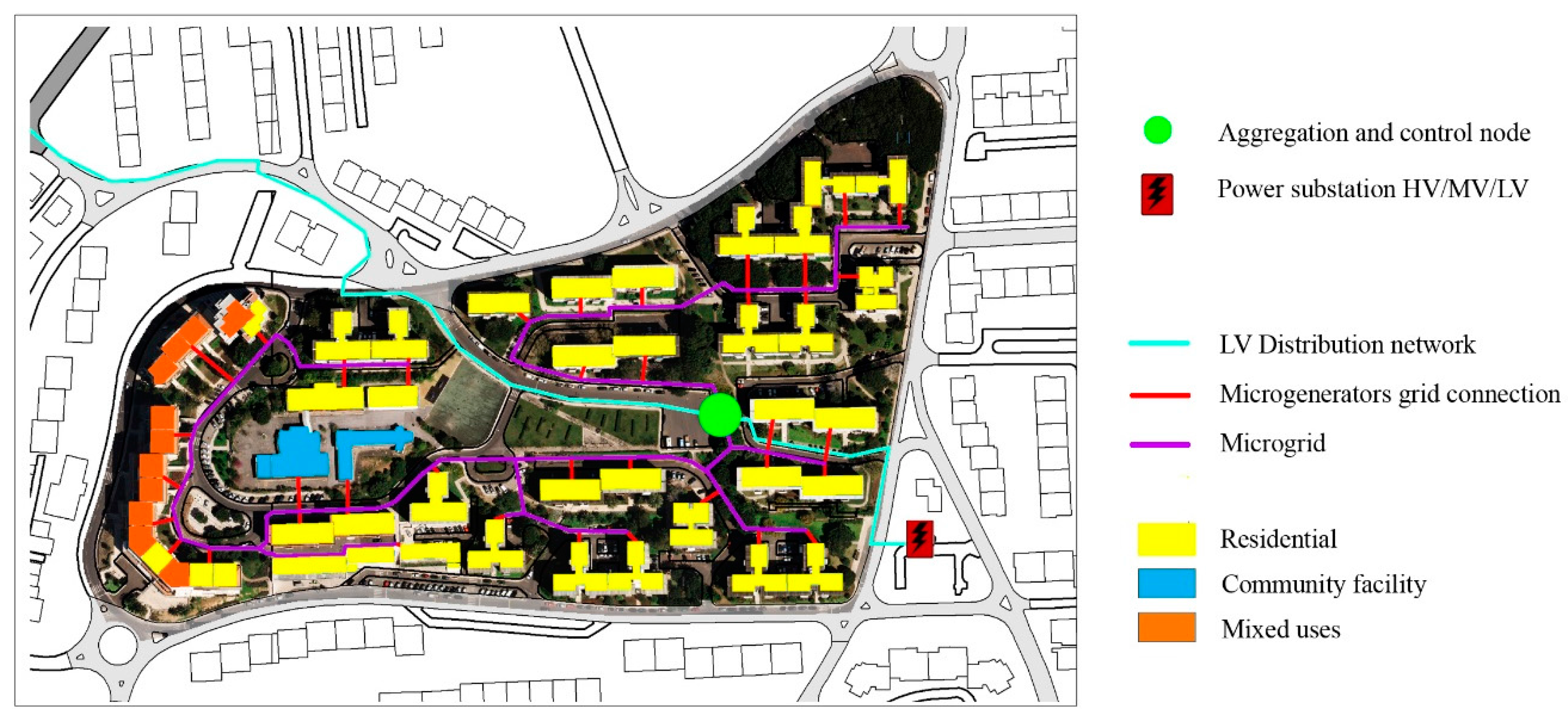
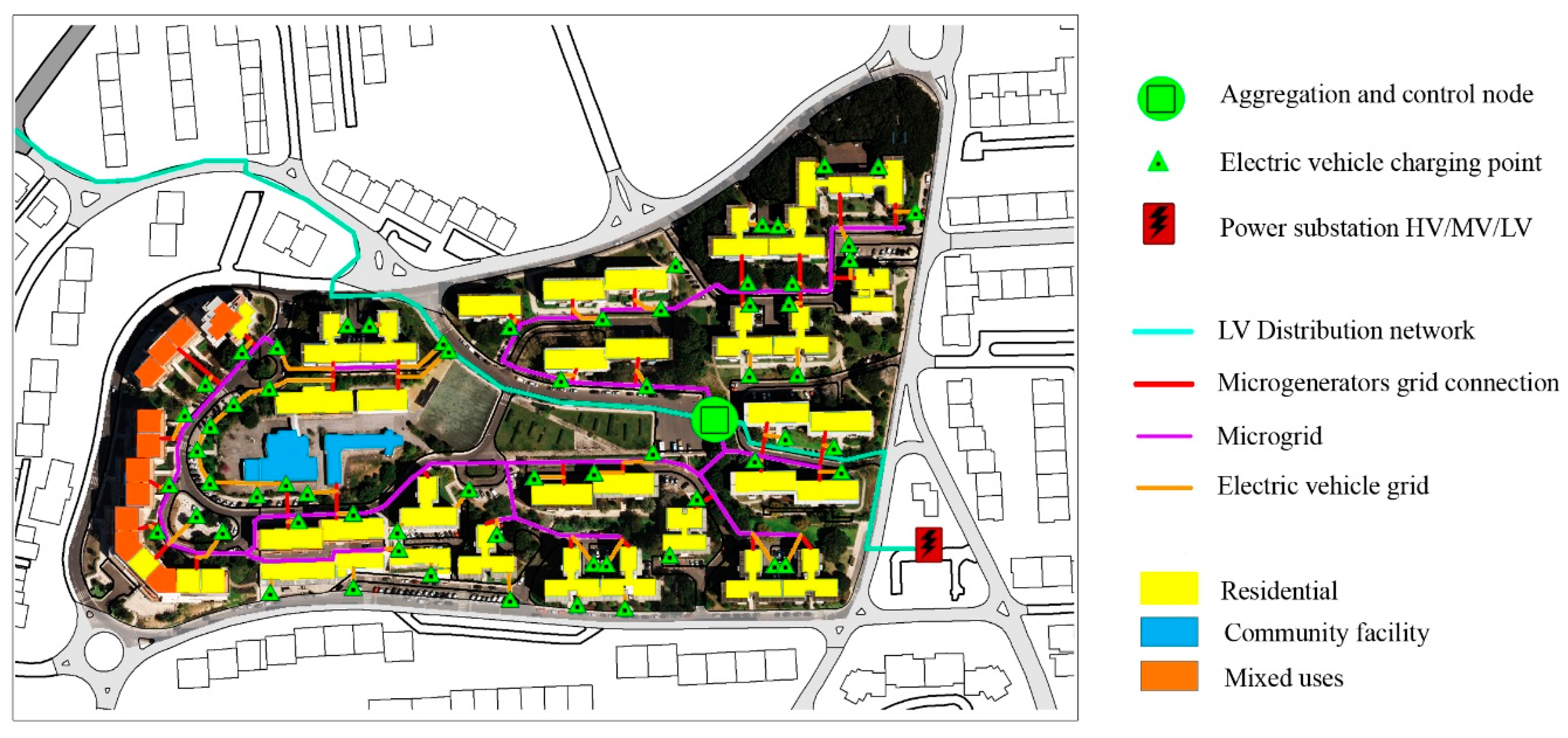
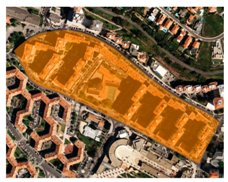 | 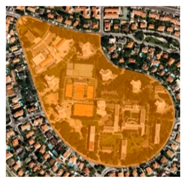 | 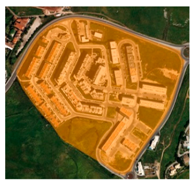 |
| LINEAR CELL | PUNCTUAL CELL | NON-ORTHOGONAL CELL |
 | 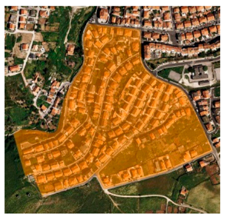 | 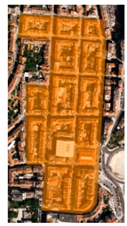 |
| RADIAL CELL | ORGANIC CELL | ORTHOGONAL CELL |
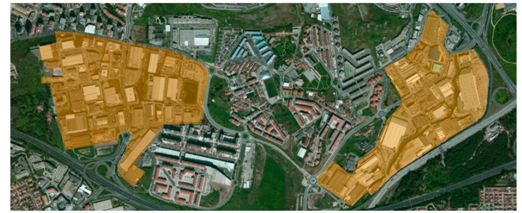 | ||
| INDUSTRIAL CELLS | ||
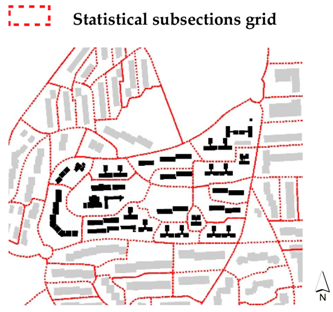 | Period of Construction | years | |
| Resident Population | N° | ||
| Buildings Block and Street Pattern | Orthogonal | ||
| Warped Parallel | |||
| Organic | |||
| Linear and Loops | |||
| Residential Building Types | Multifamily low-mid-high rise | ||
| Single family attached—detached | |||
| Roof Typology | Pitched | ||
| Flat | |||
| Zoning | Residential | Parks and Recreation | |
| Commercial | Service | ||
| Industrial | Public facility | ||
| Land-Use Coverage System | Buildings covered area | ||
| Open space area | |||
| Street covered area | |||
| Building Types | Façade Orientation | |
 Multifamily low/mid-rise | 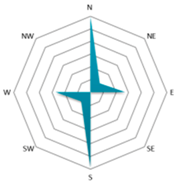 | |
| Morphology | Land Use Pattern | Land-Use Coverage System |
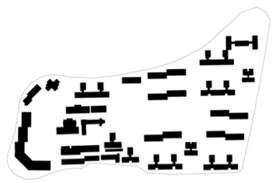 |  | 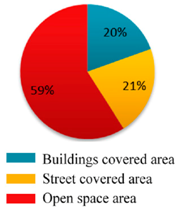 |
| Street Pattern | Roof Typology | Period of Construction |
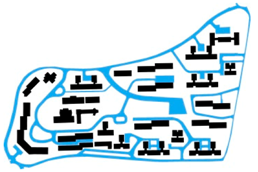 Organic |  | 1960-70 |
| Resident Population | ||
| 842 | ||
| i. Solar Radiation Simulation Obtained from Diva | ||
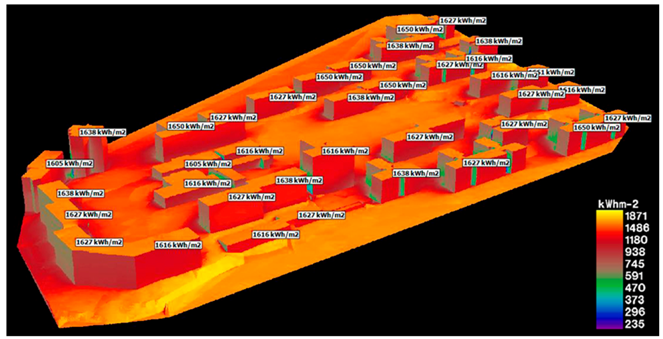 | ||
| ii. Predicted Annual Yield for PV Systems on Available Roof Area (kWh) | 1.576.178 | |
| iii. Average Annual Electricity Consumption for Each Subsection of the Urban Unit (kWh/year) | ||
 | ||
| iv. Average Annual Electricity Consumption of the Urban Unit (kWh/year) | 984.192 | |
| v. Differential between Energy Production and Consumption | 62% Positive | 38% Negative |
© 2017 by the authors. Licensee MDPI, Basel, Switzerland. This article is an open access article distributed under the terms and conditions of the Creative Commons Attribution (CC BY) license (http://creativecommons.org/licenses/by/4.0/).
Share and Cite
Amado, M.; Poggi, F.; Ribeiro Amado, A.; Breu, S. A Cellular Approach to Net-Zero Energy Cities. Energies 2017, 10, 1826. https://doi.org/10.3390/en10111826
Amado M, Poggi F, Ribeiro Amado A, Breu S. A Cellular Approach to Net-Zero Energy Cities. Energies. 2017; 10(11):1826. https://doi.org/10.3390/en10111826
Chicago/Turabian StyleAmado, Miguel, Francesca Poggi, António Ribeiro Amado, and Sílvia Breu. 2017. "A Cellular Approach to Net-Zero Energy Cities" Energies 10, no. 11: 1826. https://doi.org/10.3390/en10111826
APA StyleAmado, M., Poggi, F., Ribeiro Amado, A., & Breu, S. (2017). A Cellular Approach to Net-Zero Energy Cities. Energies, 10(11), 1826. https://doi.org/10.3390/en10111826







